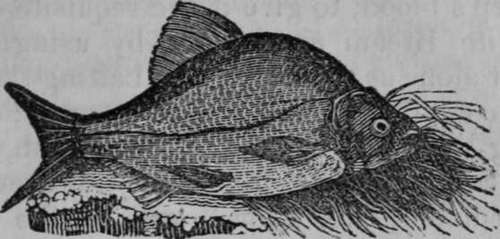A Description Of A Bream
Description
This section is from the book "The Art Of Angling Greatly Improved", by An Unknown Author. Also available from Amazon: The Art of Angling Greatly Improved.
A Description Of A Bream
The Bream grows to a very large size, sometimes to five or six pounds. The larger ones are called Carp Bream, as they are yellow, resembling the Carp in colour, and are supposed to be a distinct species from the White Bream. They frequent the broadest parts of the river, where it is deep, and the stream gentle. They are also to be found in mill-ponds, in the vicinity of weeds, and in clayey or muddy bottoms.

The best months for angling are August and September, very early in the morning or after sun-set. The lob-worm is the best bait for the larger Bream, and the place ought to be baited with them for some time previously. The following may also be considered as good baits : flag-worms, gentles, wasp-grubs, marsh-worms, and brandlings, paste, greenflies, and the grasshopper with his legs cut off.
A good paste for Bream is made of white new bread worked in the hand to a proper consistency, and coloured with vermilion, or sheep's blood, to give it the requisite colour. White Bream are caught by using boiled malt alone as a ground-bait, baiting the hook with gentles or well-scoured worms; a running-line must be used, and a plumb, as directed for Barbel. The hook, however, must be smaller, No. 2 or 3 will be the proper size.
The Bream bites best when there is a slight breeze, but when the water is rough the bait must be placed near the bottom. They bite very slowly, and the larger they are the slower they bite. The bait should be laid in softly in the middle of the ground-bait, but let not the lead be above two feet under water. W hen the fish bites he will throw up the float, and when it is perceived to lie flat upon the surface of the water, it may then be concluded that the fish has gorged the bait; strike it gently, and hold the rod at a bend for a short time, for if you both pull the fish may be lost, if not also the hook and line.
The Bream affords noble sport, but is a fish very shy to be landed. His favourite harbour is the water-dock; but having once hooked him, care must be taken to keep him from that quarter, for he will strive to get thither, in order that the line may be entangled about the stalks of the dock, which being by nature very tough, it will be impossible to disengage him from them. It is not advisable to angle more than three or four days for Bream in the same place, for the fish become shy and wary, and then afford very little sport.
The angler should cautiously avoid standing close to the water's edge, after he has deposited the line. Two or three rods and lines may be used at the same time of fishing in still water.
Continue to:
